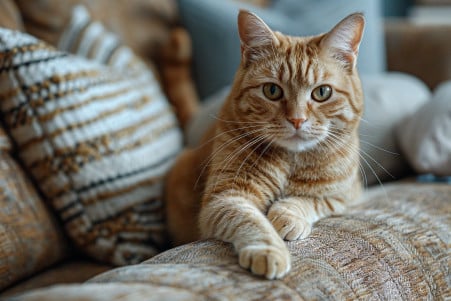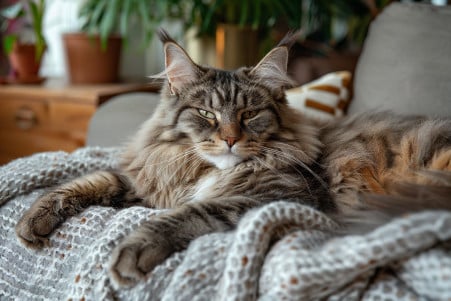Why Doesn't My Cat Actually Make Biscuits When Kneading? Decoding Feline Behavior
3 May 2024 • Updated 2 May 2024

If you’ve ever watched your cat knead your lap, you’ve probably asked yourself this question. Kneading, or “making biscuits,” is a behavior that kittens start when nursing to help stimulate their mother’s milk flow. As a result, adult cats often knead soft surfaces to help themselves feel more comfortable and secure.
So why don’t cats take the next step and actually make some bread? The answer is complicated and involves a number of different factors. In this article, we’ll explore ethological research that has uncovered the evolutionary roots and functions of this instinctual behavior. We’ll also discuss the findings of animal behaviorists who have investigated the ways a cat’s physiology, personality, and environment can impact how and when they knead.
Why doesn't my cat make biscuits when kneading?
Why Don't All Adult Cats Knead?
Despite the fact that kneading is a common cat behavior, not all adult cats do it. There are a number of reasons why some cats may not knead. According to Cats.com, one of the biggest factors is a cat's early experiences as a kitten, particularly if they were separated from their mother before they were 8 weeks old. Catster also points out that some breeds, such as Siamese, are less likely to knead.
A cat's personality and living situation are also important, according to UAHPet. Cats that are shy, insecure, or living in stressful environments may not feel safe enough to knead. A lack of appropriate surfaces to knead on can also discourage the behavior. Finally, medical conditions, such as arthritis or past injuries, can make kneading painful, leading cats to avoid it, according to Cats.com.
In other words, while kneading is an instinctive behavior for cats, there are many factors that can determine whether or not a cat will continue to do it as an adult. These factors include a cat's early experiences, personality, living situation, and health. Early separation from a cat's mother seems to be one of the most important factors, and it can set the stage for future kneading issues.
Early Separation and Kneading Behavior
Kittens that are separated from their mothers too early, which is generally before 8-10 weeks, can experience a number of behavioral problems that are related to kneading. According to Pet Wellbeing, if kittens aren’t properly weaned and don’t have the opportunity to learn from their mothers, they may have a hard time learning the right way to knead and other social behaviors. As a result, some kittens that are separated from their mothers too early may engage in excessive or compulsive kneading, suckling, or chewing as they attempt to recreate the nursing experience.
Meanwhile, CatGenie explains that other kittens may never knead at all if they weren’t able to learn the behavior during the critical period. The Orange County Register also points out that early separation can lead to other issues like poor litter box habits, aggression, shyness, and poor litter box habits, all of which could indirectly impact kneading.
Why Some Cats Don't Knead
While kneading is a common behavior, not all cats do it. In fact, according to Scientific American, some cats may knead without the pushing and alternating paw movements that are part of the classic "making biscuits" behavior. Individual differences, breed differences, and the way the behavior is learned from the mother can all contribute to differences in kneading style.
According to PetMD, cats that were separated from their mothers too early or experienced other disruptions in their early development are more likely to show atypical kneading patterns. Meanwhile, while kneading is often seen as a sign of contentment, PetCube points out that the lack of kneading doesn't mean a cat isn't showing affection or feeling good. Some cats simply have other ways of expressing happiness and love.
How to Promote Healthy Kneading in Cats
While kneading is a natural behavior, excessive or compulsive kneading can be a sign of stress, anxiety, or discomfort in cats. According to The Conversation, if the kneading and especially sucking occur very frequently, for a long time, appear compulsive or are beginning to damage your cat's paws, legs or mouth, it may be a sign your cat is stressed or in pain and needs to see a vet.
To promote healthy kneading in cats, make sure they have plenty of soft, comfortable surfaces to knead on. This can help prevent them from kneading on hard surfaces, which can be destructive to their paws. Daily Paws recommends placing a thick, soft folded blanket on your lap so you can't feel the cat's nails, and training them to knead only on that blanket.
You can also use positive reinforcement to encourage your cat to knead in a healthy way. Meow Mix suggests giving your cat a treat to distract or reward them for kneading on the right surfaces.
Pheromone sprays or diffusers can help create a calming environment that may reduce excessive kneading caused by stress or anxiety, as noted by The Conversation. If a cat suddenly stops kneading or exhibits other concerning behavioral changes, it's essential to consult a veterinarian to rule out any underlying medical issues.
Conclusion: Understanding and Accepting Kneading Behavior
Kneading, or 'making biscuits', is a natural and instinctive behavior that kittens learn from their mothers while nursing. According to Cat Behavior Explained, kittens use this kneading motion to stimulate milk flow and bond with their mother. Even as adult cats, many will continue to knead as a way to recreate those comforting feelings from kittenhood.
That said, not all cats knead in the classic 'biscuit-making' style. According to Catster, some cats may knead without the alternating paw movements. This can be due to personal preference, breed differences, or even developmental issues. Cats that were weaned from their mothers too early are more likely to knead in ways that are different from the 'biscuit-making' style.
While excessive kneading can be a sign of stress or anxiety, The Conversation suggests that providing the right surfaces and positive reinforcement can help to encourage healthy kneading. It's also important to see a vet if a cat suddenly stops kneading or shows other changes in behavior.
In the end, knowing where kneading comes from and why cats may knead in different ways can help cat owners accept and even celebrate their cat's unique kneading style. By making sure their cats feel safe and secure, cat owners can help their pets enjoy this instinctive and comforting behavior.


